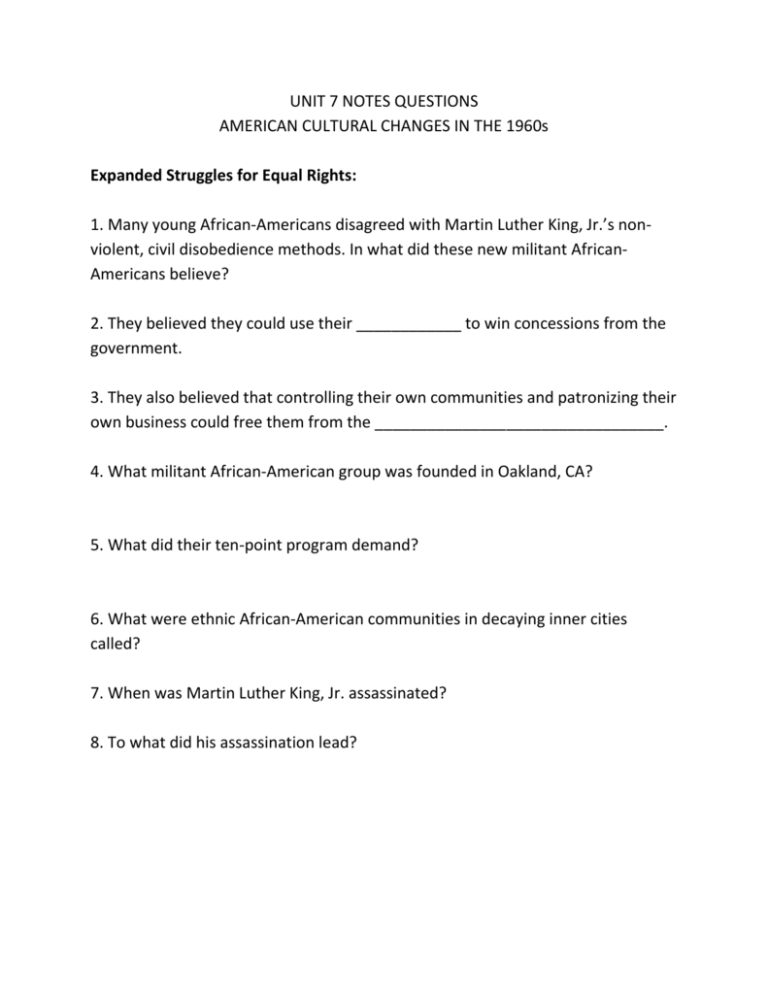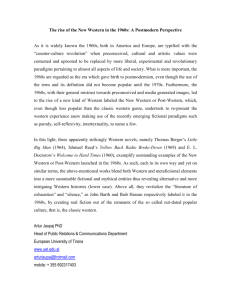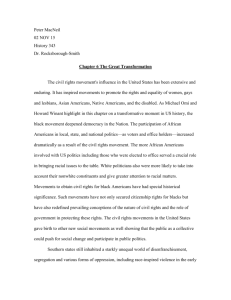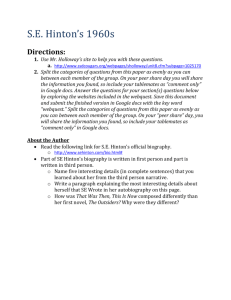American Cultural Changes Notes Questions
advertisement

UNIT 7 NOTES QUESTIONS AMERICAN CULTURAL CHANGES IN THE 1960s Expanded Struggles for Equal Rights: 1. Many young African-Americans disagreed with Martin Luther King, Jr.’s nonviolent, civil disobedience methods. In what did these new militant AfricanAmericans believe? 2. They believed they could use their ____________ to win concessions from the government. 3. They also believed that controlling their own communities and patronizing their own business could free them from the _________________________________. 4. What militant African-American group was founded in Oakland, CA? 5. What did their ten-point program demand? 6. What were ethnic African-American communities in decaying inner cities called? 7. When was Martin Luther King, Jr. assassinated? 8. To what did his assassination lead? 9. What three things did a commission find led to unrest by African-Americans in the late 1960s and early 1970s? a. b. c. Use the power point slides and handout to start the graphic organizer on the next page. 10. What term was used to describe Mexican Americans in the 1960s? 11. On what did the Chicano Movement focus? 12. Who were three leaders of the Chicano Movement? a. b. c. 13. In addition to activism, Mexican Americans expressed themselves through greater appreciation of their culture. Why did they begin painting murals in their neighborhoods? 14. What did the murals provide? Use the power point slides and handout to add to the graphic organizer on the next page. 15. Why was the American Indian Movement (AIM) formed? 16. What was it seeking? 17. What slogan did they use? 18. What was one way they demonstrated? Use the above information to complete your graphic organizer on the next page. The Women’s Liberation Movement: 1. What is another name for the Women’s Liberation Movement? 2. What was the aim of the movement? 3. What was the chief voice of the movement? 4. Who wrote The Feminine Mystique in 1963? What belief did it challenge? 5. What created greater gender equality in universities? 6. What law requires equal pay for equal work? 7. List at least 4 ways feminists tried to change attitudes (what did they oppose?). a. b. c. d. 8. What was the significance of Roe v. Wade (1973)? 9. What is the significance of Title IX? 10. What will happen to a school that violates Title IX (in other words, what would it lose)? Use the power point slides and handout of the Women’s Rights Movement to help create a mind map. You may use SimpleMind on your iPad or do it on paper. Your Topic is The Women’s Rights Movement. Your subtopics are: New Attitudes Affirmative Action Title IX Equal Pay Act Women Leaders Include at least three branches/bubbles for each subtopic. Post-War Literature, Art, and Music: 1. What was the subject of the best writing following WWII? 2. What 2 novels were used by the counter-culture movement to challenge mainstream thinking by exposing the absurdity of armed conflict? 3. What was much of the literature of the 1960s about? 4. What were 2 things literature became more open about? 5. What was the Beat Generation rebelling against? 6. “Beatniks” were generally associated with artistic lifestyles. Describe what “Beatniks” looked like and what they experimented with. 7. What two types of art were popular in the post-war era? 8. What kind of music replaced the Big Band music of the 1940s? 9. On what new technology did it depend? 10. Where did Motown originate? 11. List three bands that became popular in the United States as a result of the “British Invasion.” a. b. c. 12. What were two topics that were reflected in the music of counter-culture artists? 13. What were three things that influenced young people in the 1960s and early 1970s? a. b. c. 14. What did the Youth Culture challenge? 15. New Lifestyles for young people were influenced by rock music. What were symbols of the new culture and with what did they experiment? 16. Why were “hippies” unique? 17. What did the twenty-sixth amendment do? On a separate sheet of paper, or your iPad, write a brief comparison essay telling how the Beat Generation of the 1950s and the Youth Culture of the 1960s were the same and how they were different.











